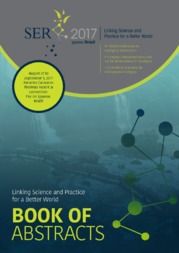Photosynthetically active radiation under forest fragment and forest restoration systems in the Cerrado-Amazon ecotone, Mato Grosso State, Brazil.
Photosynthetically active radiation under forest fragment and forest restoration systems in the Cerrado-Amazon ecotone, Mato Grosso State, Brazil.
Author(s): ZOLIN, C. A.; LULU, J.; TONINI, H.; ISERNHAGEN, I.
Summary: In this study we monitored the Photosynthetically Active Radiation (PAR) in four treatments of a Forest Restoration (FR) project, as well as inside a Native Forest (NF) and under Full Sun (FS) condition during 651 days, in Cerrado-Amazon ecotone, Brazil. The FR systems were established in December 2012 and consisted of a consortium of 16 native species with eucalyptus (T1) and with rubber trees (T2), both with artificial pruning (AP), and only native species with (T3) and without AP (T7), all with a density of ~800 ind.ha-1. The PAR data was acquired continuously with specific sensors coupled to automatic weather stations and data loggers, while tree height and shading were measured inside circular plots around the stations after four years of planting. According to the paired T test, in all treatments, the available PAR (MJ m-2 day-1) during the studied period presented significant differences (P <0.01), with mean values of 5.08 (T1), 5.28 (T2), 5.65 (T3), 4.94 (T7), 7.17 (FS) and 0.19 (NF). As expected, NF had the lowest level of PAR, while the FR treatments are already showing some level of shading that will allow the gradative suppression of exotic grasses and the establishment of natural regeneration. The lowest level of PAR at T7, even with T1 having high individuals of eucalyptus, may be due to the lack of AP. However, as we expect to provide wood as a major product of the forest management, the challenge will be to balance this management with the return of natural processes.
Publication year: 2017
Types of publication: Abstract in annals or event proceedings
Observation
Some of Embrapa's publications are published as ePub files. To read them, use or download one of the following free software options to your computer or mobile device. Android: Google Play Books; IOS: iBooks; Windows and Linux: Calibre.
Access other publications
Access the Agricultural Research Database (BDPA) to consult Embrapa's full library collection and records.
Visit Embrapa Bookstore to purchase books and other publications sold by Embrapa.

